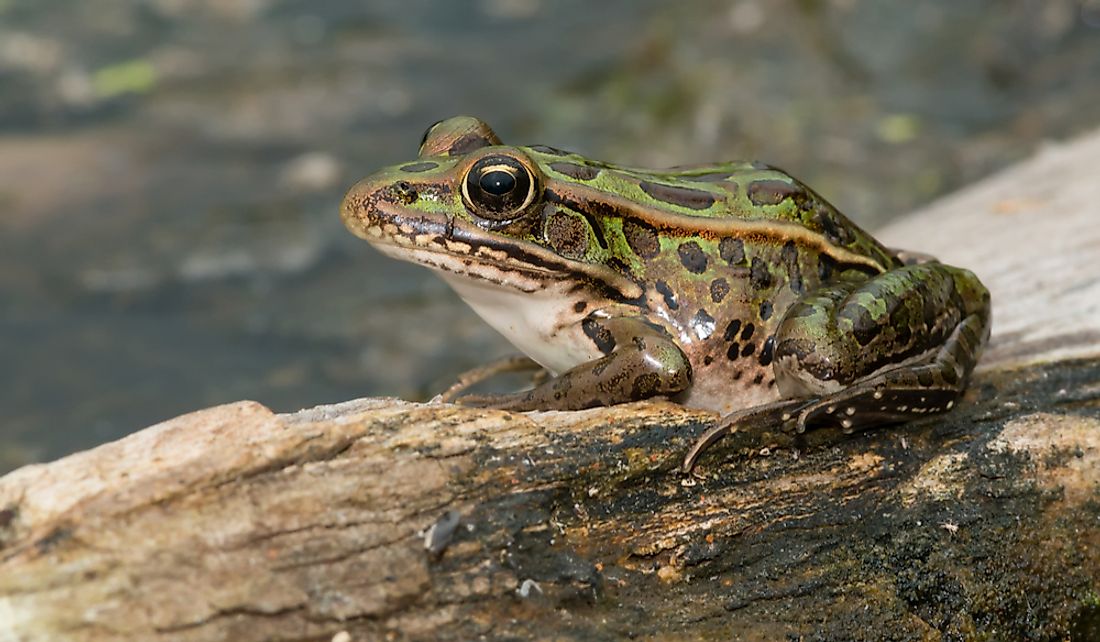What Is The Vermont State Amphibian?

Vermont is a US state located in the northeastern part of the country and borders the Canadian province of Quebec. The state covers an area of 9,616 sq mi and has a population of 626,299, ranking as the 6th smallest in terms of area and second least populous in the country. Vermont is nicknamed "The Green Mountain State," and uses the following motto: Freedom and Unity. In addition to its official motto, Vermont has also designated various state symbols, including a state flag, state tree (sugar maple), state flower (red clover), state bird (hermit thrush), state insect (western honey bee), and state mammal (Morgan horse). Vermont also has a state amphibian: the northern leopard frog.
Northern Leopard Frog
Vermont's official state amphibian is the northern leopard frog, which is sometimes referred to as the grass frog or meadow frog. While its scientific name is Lithobates pipiens, the frog's common name reflects the large black spots on its body that resemble those of a leopard.
Range and Habitat
Northern leopard frogs are native to parts of the United States and Canada. In particular, they thrive in temperate and subtropical climates, but can also easily adapt to new environments, including desserts, mountain meadows, marshes, freshwater areas full of vegetation, and swampy fields.
Physical Features
Northern leopard frogs are typically green or brown in color, with prominent black spots, and a white underside. The species is relatively large and can grow up to 3.5 inches in length. The northern leopard frog also has a line that starts behind each eye and runs down its back, named dorsolateral folds.
Behavioral Characteristics
The northern leopard frog feeds on insects and pests, such as flies, beetles, leafhoppers, and ants. It also consumes slugs, pill bugs, snails, and worms, and given its large mouth, even small birds and garter snakes. As a result, the northern leopard frog has been instrumental in managing the population of pests and insects in Vermont ponds. The frog hunts by using the "sit-and-wait strategy," which means that it waits until prey is close enough before pouncing. The species is both nocturnal and diurnal, and its predators include certain types of snakes, herons, turtles, grebes, fish, mergansers, and larger frogs. The northern leopard frog hibernates from October until March, hiding in streams and deep ponds that contain sufficient oxygen needed for survival.
Reproduction and Life Cycle
The northern leopard frog usually mates between late April and early June. The reproduction process starts with males gathering in water and then calling females using loud croaks. Females can lay as many as 6,500 eggs in the water, and the embryos develop into hatchlings, which then grow to become free-swimming tadpoles. Metamorphosis eventually occurs transforming the tadpoles into little frogs. The northern leopard frog can live for about four years in the wild or up to nine years in captivity.
Environmental Threats and Conservation Status
The northern leopard frog faces the threat of habitat loss, which impacts its long-term survival. It also suffers from environmental changes, such as increased frequency of droughts. According to the International Union for Conservation of Nature's (IUCN) Red List, the frog is classified as a species of "Least Concern."
Designating the Vermont State Amphibian
The northern leopard frog was designated as Vermont's state amphibian in 1998 after the signing of Senate Bill No. 241 by Governor Howard Dean, which came into effect on July 1 of that year. The frog's beautiful green color is said to symbolize Vermont’s natural beauty. Additionally, the northern leopard frog plays an important role in the ecosystem of Vermont's lakes and ponds, as it helps control the insect population and eats algae.











